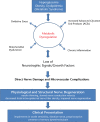Physical Training and Activity in People With Diabetic Peripheral Neuropathy: Paradigm Shift
- PMID: 27445060
- PMCID: PMC6256941
- DOI: 10.2522/ptj.20160124
Physical Training and Activity in People With Diabetic Peripheral Neuropathy: Paradigm Shift
Abstract
Diabetic peripheral neuropathy (DPN) occurs in more than 50% of people with diabetes and is an important risk factor for skin breakdown, amputation, and reduced physical mobility (ie, walking and stair climbing). Although many beneficial effects of exercise for people with diabetes have been well established, few studies have examined whether exercise provides comparable benefits to people with DPN. Until recently, DPN was considered to be a contraindication for walking or any weight-bearing exercise because of concerns about injuring a person's insensitive feet. These guidelines were recently adjusted, however, after research demonstrated that weight-bearing activities do not increase the risk of foot ulcers in people who have DPN but do not have severe foot deformity. Emerging research has revealed positive adaptations in response to overload stress in these people, including evidence for peripheral neuroplasticity in animal models and early clinical trials. This perspective article reviews the evidence for peripheral neuroplasticity in animal models and early clinical trials, as well as adaptations of the integumentary system and the musculoskeletal system in response to overload stress. These positive adaptations are proposed to promote improved function in people with DPN and to foster the paradigm shift to including weight-bearing exercise for people with DPN. This perspective article also provides specific assessment and treatment recommendations for this important, high-risk group.
© 2017 American Physical Therapy Association.
Figures




References
-
- Mueller MJ, Minor SD, Sahrmann SA et al. . Differences in the gait characteristics of patients with diabetes and peripheral neuropathy compared with age-matched controls. Phys Ther. 1994;74:299–308. - PubMed
-
- Simoneau GG, Ulbrecht JS, Derr JA et al. . Postural instability in patients with diabetic sensory neuropathy. Diabetes Care. 1994;17:1411–1421. - PubMed
-
- Maluf KS, Mueller MJ. Comparison of physical activity and cumulative plantar tissue stress among subjects with and without diabetes mellitus and a history of recurrent plantar ulcers. Clin Biomech. 2003;18:567–575. - PubMed
-
- van Sloten TT, Savelberg HH, Duimel-Peeters IG et al. . Peripheral neuropathy, decreased muscle strength and obesity are strongly associated with walking in persons with type 2 diabetes without manifest mobility limitations. Diabetes Res Clin Pract. 2011;91:32–39. - PubMed
Publication types
MeSH terms
Grants and funding
LinkOut - more resources
Full Text Sources
Other Literature Sources
Medical

